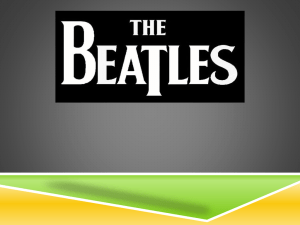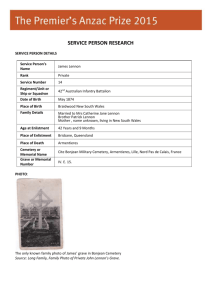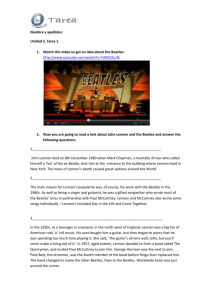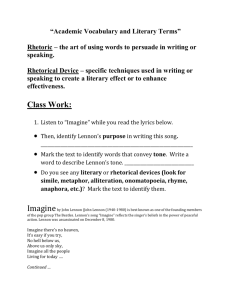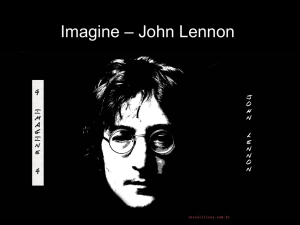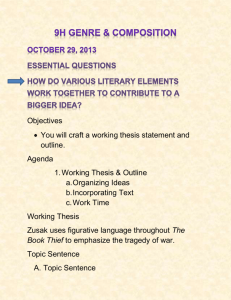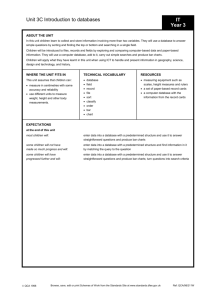Termly_Planning_John_Lennon - The Dudley Grid For Learning
advertisement
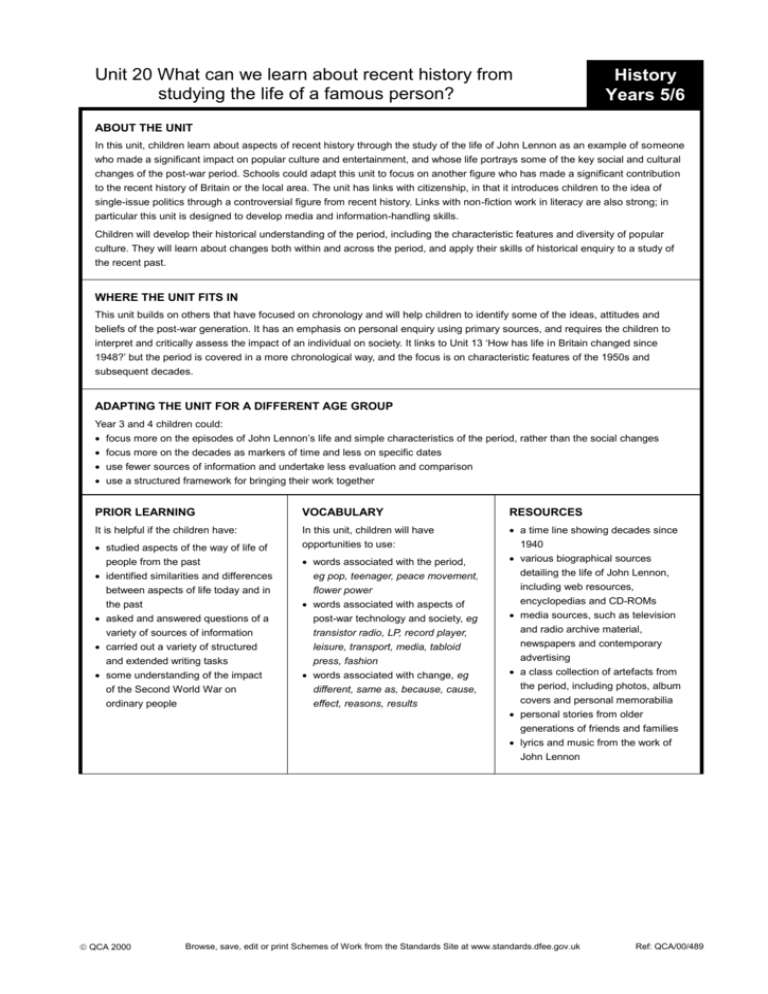
Unit 20 What can we learn about recent history from studying the life of a famous person? History Years 5/6 ABOUT THE UNIT In this unit, children learn about aspects of recent history through the study of the life of John Lennon as an example of someone who made a significant impact on popular culture and entertainment, and whose life portrays some of the key social and cultural changes of the post-war period. Schools could adapt this unit to focus on another figure who has made a significant contribution to the recent history of Britain or the local area. The unit has links with citizenship, in that it introduces children to the idea of single-issue politics through a controversial figure from recent history. Links with non-fiction work in literacy are also strong; in particular this unit is designed to develop media and information-handling skills. Children will develop their historical understanding of the period, including the characteristic features and diversity of popular culture. They will learn about changes both within and across the period, and apply their skills of historical enquiry to a study of the recent past. WHERE THE UNIT FITS IN This unit builds on others that have focused on chronology and will help children to identify some of the ideas, attitudes and beliefs of the post-war generation. It has an emphasis on personal enquiry using primary sources, and requires the children to interpret and critically assess the impact of an individual on society. It links to Unit 13 ‘How has life in Britain changed since 1948?’ but the period is covered in a more chronological way, and the focus is on characteristic features of the 1950s and subsequent decades. ADAPTING THE UNIT FOR A DIFFERENT AGE GROUP Year 3 and 4 children could: focus more on the episodes of John Lennon’s life and simple characteristics of the period, rather than the social changes focus more on the decades as markers of time and less on specific dates use fewer sources of information and undertake less evaluation and comparison use a structured framework for bringing their work together PRIOR LEARNING VOCABULARY RESOURCES It is helpful if the children have: In this unit, children will have opportunities to use: a time line showing decades since 1940 various biographical sources detailing the life of John Lennon, including web resources, encyclopedias and CD-ROMs media sources, such as television and radio archive material, newspapers and contemporary advertising a class collection of artefacts from the period, including photos, album covers and personal memorabilia personal stories from older generations of friends and families lyrics and music from the work of John Lennon studied aspects of the way of life of people from the past identified similarities and differences between aspects of life today and in the past asked and answered questions of a variety of sources of information carried out a variety of structured and extended writing tasks some understanding of the impact of the Second World War on ordinary people QCA 2000 words associated with the period, eg pop, teenager, peace movement, flower power words associated with aspects of post-war technology and society, eg transistor radio, LP, record player, leisure, transport, media, tabloid press, fashion words associated with change, eg different, same as, because, cause, effect, reasons, results Browse, save, edit or print Schemes of Work from the Standards Site at www.standards.dfee.gov.uk Ref: QCA/00/489 Primary Schemes of Work: History Unit 20 What can we learn about recent history from studying the life of a famous person?. EXPECTATIONS at the end of this unit most children will: demonstrate factual knowledge of key episodes in the life of a famous person; show some understanding of key changes in post-war society and culture; be able to examine the contribution of an individual’s life to history; be able to extract and communicate selected information from historical sources some children will not have made so much progress and will: demonstrate factual knowledge of some episodes in the life of a famous person; identify and locate in time some characteristic features of the post-war years; form an opinion about the contribution of an individual’s life to a period of history; be able to extract information from historical sources some children will have progressed further and will: demonstrate an ability to assess the importance of an individual to the history of the period; have shown an ability to select and evaluate different sources of evidence QCA 2000 Browse, save, edit or print Schemes of Work from the Standards Site at www.standards.dfee.gov.uk Ref: QCA/00/489 Browse, save, edit or print Schemes of Work from the Standards Site at www.standards.dfee.gov.uk LEARNING OBJECTIVES Primary Schemes of Work: History Unit 20 What can we learn about recent history from studying the life of a famous person?. POSSIBLE TEACHING ACTIVITIES LEARNING OUTCOMES CHILDREN SHOULD LEARN to identify John Lennon from pictorial evidence and extract information to investigate, using secondary sources, some characteristic features of the 1950s POINTS TO NOTE CHILDREN know about John Lennon from information extracted from pictures and what the teacher has told them find out and record details of everyday life in the 1950s Who was John Lennon and what was his childhood like? Give out selected pictures of John Lennon from various stages of his life (photocopied from encyclopedias/taken from the internet). Ask the children if they know who he is, or when these pictures were taken. Discuss what the pictures show about his early life and the type of family he might have come from. Give some biographical details, eg place of birth/dates/historical context. There are a number of websites devoted to John Lennon and his life and times. Some of the sites would not be entirely suitable for children to access independently, because of the nature of some of Lennon’s activities. Coordinators could build up a collection of suitable pages for working off-line, or to put into their own web pages. Things to stress about the 1950s: the end of rationing, changes in popular culture and attitudes, the emergence of a strong teenage culture. Other differences in technology should be more obvious to the children. Using textbooks/reference books about the 1950s, ask the children to investigate in groups given aspects of everyday life, eg school, leisure, home life, food (rationing). Ask the children to complete a grid with the headings: What do I know? What do I think I know? What do I want to find out? The use of a grid to structure research will provide a context for pupils to use a strategy identified in non-fiction work in The National Literacy Strategy: Framework for teaching. End the activity with a plenary session and correct any misconceptions, eg that wind-up gramophones were still in common use, that all teenage boys were Teddy boys. QCA 2000 1 Ref: QCA/00/489 Browse, save, edit or print Schemes of Work from the Standards Site at www.standards.dfee.gov.uk LEARNING OBJECTIVES Primary Schemes of Work: History Unit 20 What can we learn about recent history from studying the life of a famous person?. POSSIBLE TEACHING ACTIVITIES LEARNING OUTCOMES CHILDREN SHOULD LEARN to carry out personal research to identify key reasons for the growth in popularity of pop music to compare primary and secondary sources of information about the Beatles QCA 2000 POINTS TO NOTE CHILDREN demonstrate knowledge of the 1960s from their report on the details of their personal research identify the range of different sources of evidence used discuss the value of different sources How did he become famous and why did the Beatles become so popular? Ask the children to question adults about what they know or remember about John Lennon and the Beatles in the 1960s. Ask the children to bring in artefacts that show something about the 1960s to form a class display. Ask the children to pair up and discuss briefly what they have found out/brought in, then report back to the class. Talk to the children about the growth in pop music/Beatlemania/teenage culture. Use examples of new technology such as transistor radios or 45rpm records. Try to draw attention to the different types of sources the children have used – memories, eyewitness stories and secondary accounts – and ask which sources are the most useful. Teachers could spend some time helping the children to think of suitable questions to ask and appropriate interviewees. It should be easy to set up a good collection of artefacts related to the Beatles and the 1960s, which could form a display, or be made into a mini-museum. If a museum is built up, children could use databases to record the artefacts brought in, their age and their owners. Security and insurance may need to be considered for any potentially valuable artefacts. Stress the importance of changes in technology in increasing access to music for teenagers. Radios became cheaper and smaller and singles records were affordable. To evaluate the sources, point out differences between the sources and talk about where they came from and why certain things are remembered by some and not by others. 2 Ref: QCA/00/489 Browse, save, edit or print Schemes of Work from the Standards Site at www.standards.dfee.gov.uk LEARNING OBJECTIVES Primary Schemes of Work: History Unit 20 What can we learn about recent history from studying the life of a famous person?. POSSIBLE TEACHING ACTIVITIES LEARNING OUTCOMES CHILDREN SHOULD LEARN POINTS TO NOTE CHILDREN to identify characteristic ideas in consumer marketing and design from the 1960s to compare these ideas with current image building of celebrities in the music business to sequence a series of pictures and identify changes in image to compare differences between images from different periods How did the Beatles promote themselves and how did this change over time? Use a series of pictures of the Beatles from different stages of their careers. Divide the children into groups and ask each group to discuss what image they think the band is trying to portray. Ask the children if they think it is effective. Discuss the reasons for conveying that image. Ask the children how it compares with the marketing of bands now. to extract information from reference material including the internet and CD-ROMs to find out about aspects of political awareness and protest in the 1970s to use music as a source of historical information What was John Lennon known for after the Beatles? Use reference material to find out why the group stopped working together and what John Lennon did after that. Focus on the political nature of his activities. What was he doing to gain publicity? What was he trying to tell people or achieve? Ask the children to produce a sequence of Beatles’ pictures in chronological order and describe the images and underlying messages being conveyed. Ask the children to complete a comparison grid, looking at the differences between the images of bands and design ideas in the 1960s and today. Listen to ‘Imagine’ or another Lennon song from the 1970s with political lyrics. Use OHT sheets to analyse lyrics and discuss the context further. make inferences about the Beatles from the evidence collected/shown identify characteristics of style and design from the period sequence the pictures in a chronological order compare and contrast the images of the 1960s with those from the 1990s and today It would be useful to ask some children to bring in contemporary marketing material for current groups to act as a point of comparison. Photographs from magazines and other promotional material could be used. demonstrate knowledge of the life and work of the Beatles and John Lennon from the information extracted from a range of sources link the lyrics of the song to other events and activities from his life Most history textbooks on the period will contain relevant information for this. There will be entries on CD-ROM encyclopedias about the Beatles and John Lennon. It is important that this material is analysed critically and that children realise the way in which image is manufactured to convey certain messages. Some children would only be able to identify differences and changes. Children should be made aware of the widely differing reactions to bands such as the Beatles: some saw them as a threat to the establishment, some frowned upon them for ‘corrupting’ young people, and others encouraged young people to enjoy their music. There may well be editorials/critical stories from broadsheet and tabloid newspapers that convey this. It is very important to talk with the children about how to extract the information. It is also important to guide children towards appropriate aspects of his life. It may or may not be considered appropriate to look at drugs and moral issues in this context. His own texts will contain some unsuitable vocabulary. Children could learn the song in a music lesson to reinforce the learning about how and why it was written. QCA 2000 3 Ref: QCA/00/489 Browse, save, edit or print Schemes of Work from the Standards Site at www.standards.dfee.gov.uk LEARNING OBJECTIVES Primary Schemes of Work: History Unit 20 What can we learn about recent history from studying the life of a famous person?. POSSIBLE TEACHING ACTIVITIES LEARNING OUTCOMES CHILDREN SHOULD LEARN to examine the portrayal of a key event from contemporary newspaper and TV news reports to provide an account of a historical event based on more than one source CHILDREN How did people react to the death of John Lennon? Ask the children to find out about John Lennon’s death and the impact of this. Why were people so moved by it? What did people do to mark it? Discuss the way the event was reported, looking at the types of headlines written and pictures used. Ask the children to write a factual account of what happened. Discuss their accounts. Which sources did you base them on? Why? recognise similarities and differences between reports in different media and give reasons for the differences produce a factual account of the events, drawing on appropriate sources It is important to be aware of the sensational nature of some of the reporting on events such as this. summarise the key events of John Lennon’s life in a chronological sequence, using appropriate time conventions in discussion, assess the significance of John Lennon’s life Discussing the impact of his life may be difficult, but a wellstructured discussion could provoke some insightful comments from the children. They could compare him to more contemporary figures who use their celebrity to promote certain causes. How effective do the children think this is? Look at newspaper/TV news reports and compare the accounts. Why are they different? Which are more reliable? Why? to place events in a chronological sequence and use appropriate vocabulary to relate these events to markers of time to compile a historical narrative to select information to represent key aspects of a biography to begin to evaluate the impact of an individual on the history of his times QCA 2000 POINTS TO NOTE What impact did John Lennon have on the history of this period? Ask the children to discuss in small groups how to represent John Lennon’s life and achievements. They could consider eg zig-zag books, displays, playscripts, multimedia presentation, narrative accounts. Ask the children (in groups of no more than four) to produce their own representation. Encourage the children to select the events and activities that they think were most significant for the history of the period. Most national newspapers can be contacted to request access to archive articles and headlines. This work could be evaluated under the non-fiction reading comprehension in the National Literacy Strategy (NLS). More able children might consider whether his early death has made him more famous than he would have been otherwise. Are there similarities with other recent events? Encourage the children to look at the mistakes he may have made in his life, as well as his successes. When discussing the differences in their interpretations, children should be asked to justify why they chose certain events over others. Hold a plenary discussion and ask questions such as What should John Lennon be remembered for? Why? What impact did he have on the history of his times? Has his life made an impact on our lives today? This work could lead into the presentation of an assembly to other children in the school. 4 Ref: QCA/00/489
